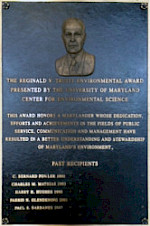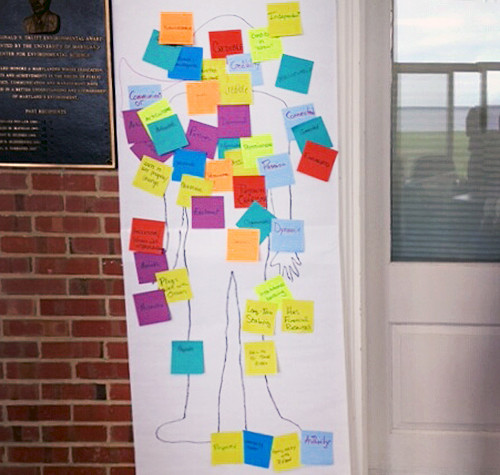Determining what makes a good environmental champion
Bill Dennison ·This blog is part of the Basin Report Card Initiative: a partnership between the World Wildlife Fund (WWF) and the University of Maryland Center for Environmental Science (UMCES)
At our initial retreat held on the front porch of UMCES Center Administration in October 2015, we asked the question "What qualities constitute a good environmental champion?" To address this question, Sarah Freeman from WWF drew a human outline and placed it on the wall, and asked us to note down qualities that came to mind on post-it notes. In this exercise, called "SNAP", someone is chosen to call out what they wrote on one of their post-its. The person then selected where on the diagram to place the note (head for intellectual features; heart for motivational features; hands and feet for practical features). If someone else had a similar post-it, they called out "Snap" and added to the original post-it.


We quickly populated the human figure with post-its and stepped back to reflect on what it all meant. It was then that I noticed that the environmental champion that we were creating was next to the brass bas relief plaque for the Truitt Award that UMCES confers on environmental champions for Chesapeake Bay. Since we were celebrating our ninety year anniversary of when Reginald Truitt founded the Chesapeake Biological Laboratory in 1925, it was appropriate that we were defining what makes an environmental champion next to the original champion. Truitt was the son of an oysterman from Snow Hill, Maryland, and he was committed to better understanding and to better managing the Bay's resources. Reginald Truitt was truly committed to this cause, and he made personal and professional sacrifices to build the capacity of scientists to serve Maryland's citizens. It was altogether fitting and proper that we do this exercise with the likeness of Reginald Truitt looking on.

Jane Thomas constructed a word cloud of the key features of an environmental champion based on the number of times certain words were used. The word "Passionate" really stood out. This was interesting, as it is not something that is usually associated with scientists, as they are typically known for their objectivity and dispassionate personalities. Yet, it is this caring about the environment that attracted them to the field and their passion to understand nature that provides their underlying motivation. Undoubtedly, Reginald Truitt was passionate about Chesapeake Bay and the people who depended on the Bay that motivated him.
There were a series of other popular words that helped complete the picture of a good environmental champion including the following: credible, knowledgeable, articulate, trusted and charismatic. These are all noble qualities and it began to look as if we were defining a superhero. Even many of the other words, not as frequently used, also emphasized superhero attributes: believable, engaged, amiable, respected, independent, motivated. There were some attributes that are not necessarily superhero traits like stable, secure, adaptable, connected, drive, and authority, but they did not detract from the overall feeling that we were defining a superhero.

I have noted that in many recent movies and popular culture references that the villains (or supervillians) are often environmental vandals. This provides some credence to the observation that our environmental champion that we were identifying needed to be a superhero to counteract the supervillians. The problem with superheroes is that they are cartoon or otherwise fictional characters. The reality is that we need real world champions with their invariable human foibles. A champion is defined on Wikipedia as having an extraordinary amount of focus, discipline, drive and complete dedication. These are indeed traits that I observed in our WWF/UMCES partnership team. So while we may not be exactly superheroes, we can aspire to the traits identified in this exercise and combine our passion with our knowledge to achieve better environmental outcomes.
About the author
Bill Dennison

Dr. Bill Dennison is a Professor of Marine Science and Vice President for Science Application at the University of Maryland Center for Environmental Science.

